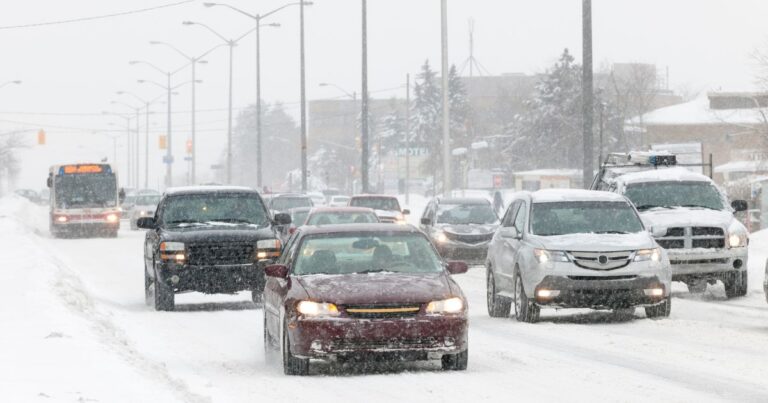
Now that winter weather is officially upon us – early sunsets, temperatures dipping below the freezing mark, snow and slush appearing on the roads, ice accumulating on tree branches and telephone wires – it’s time to make sure you and your car are both prepared for the season. Here are a few safety tips:
Prepare an Emergency Kit for Your Car
In addition to your year-round emergency supply kit, be sure to include the following:
- Warm clothing and blankets
- Drinking water (leave some empty space in the bottles so they don’t burst if they freeze)
- A first aid kit
- A flashlight and spare batteries
- Non-perishable food, such as nuts or dried fruit
- A portable charger for your cell phone
- An extra scarf or brightly colored cloth (to tie to your antenna as a signal)
Winterize Your Car
If you haven’t done so already, have your brakes, heat, battery, anti-freeze, and exhaust checked. Top up your tank more frequently, ideally anytime it is less than half full.
Notify Others of Your Travel Plans
Plan your route and let others know about it before you leave, and always check the weather first. Give notice when you depart and when you arrive. If you can avoid it, don’t travel alone.
Keep Your Car Clear of Ice and Snow
Not just the windows and mirrors, but the hood, roof, trunk, and bumpers as well. Snow and ice on your vehicle can be as much a danger to other drivers as it is to you.
Make Space for Maintenance Vehicles and Snow Plows
The sooner they can get the roads cleared, the safer everyone will be.
Slow Down!
Posted speed limits are based on dry, well-lit pavement. Like driving at night or in the rain, winter driving requires more caution.
Allow More Space and Time
Increase your following distance significantly, about three times what you would normally keep between yourself and the car ahead. Apply the brake sooner and more gradually when approaching an intersection, and turn slowly.
Turn Your Lights On
If your windshield wipers need to be on, so do your headlights.
Don’t Use Your Cruise Control, Even if the Roads are Clear
Ice and slush are not always visible, and your cruise control will not stop if you have a sudden slip or skid.
Don’t Drive Tired
When you’re low on energy, your reflexes and judgment suffer. Avoid driving late at night if you can.
Stay with your car. If you get stuck or stranded but are not in immediate danger, don’t wander off unless you can actually see help. Run the engine occasionally to keep warm, but don’t let it run constantly. To prevent carbon monoxide poisoning, check the exhaust pipe to make sure it isn’t blocked and always keep a window cracked slightly to ventilate.
As always, WEAR YOUR SEATBELT.
What about wildlife?
Deer can be a hazard at any time of year, but add into the mix their late fall/early winter mating season and increasingly dangerous winter roads, and they become a double hazard. Here are ten tips to avoid a collision with deer and other living road hazards:
- Drive at a safe speed. This means a speed that allows you to see a moving animal and respond.
- Watch for herds. Deer frequently travel in groups. If you see one, there may be others nearby.
- If you see a deer near the road, slow down. It may change speed or direction when it sees you coming.
- Take extra care at dawn and dusk. These are peak travel times for deer.
- Don’t swerve to avoid the deer. Swerving can cause a more serious accident.
- Signal to other drivers that deer are present. Flashers and headlight signals are best. Pay attention to the signals of other drivers.
- Do not count on deer whistles or fences. They are not reliable means of keeping deer off the road.
- Watch for shadows, silhouettes, or reflections in the eyes. If you see anything, slow down.
- Honk your horn if you see a deer near the road. This will get their attention better than visual signals.
- Use your high beams where possible. It will make it easier for you to spot the deer in advance.
Updated January 31, 2024
 We are a Trusted Choice independent insurance agency in Collegeville, PA providing auto, home, business, life, health and group insurance in PA, DE, MD and NJ.
We are a Trusted Choice independent insurance agency in Collegeville, PA providing auto, home, business, life, health and group insurance in PA, DE, MD and NJ.